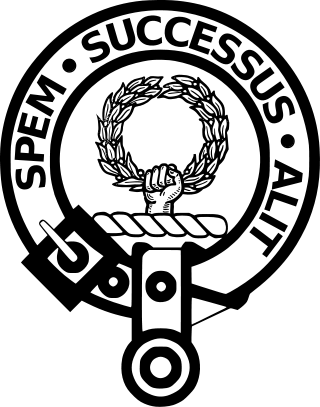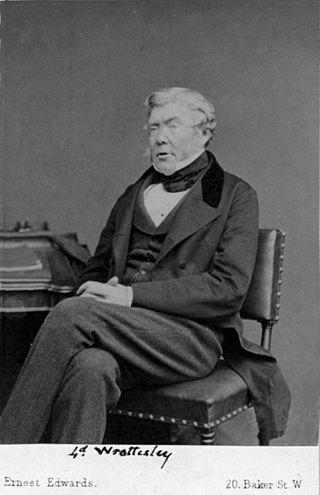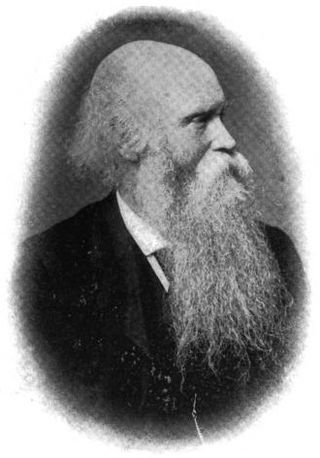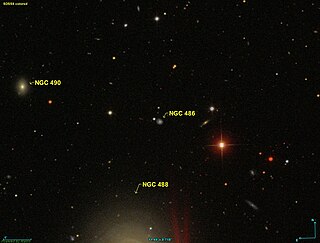Related Research Articles

Clan Ross is a Highland Scottish clan. The original chiefs of the clan were the original Earls of Ross.

Earl of Rosse is a title that has been created twice in the Peerage of Ireland, both times for the Parsons family. "Rosse" refers to New Ross in County Wexford.

William Parsons, 3rd Earl of Rosse, was an Irish astronomer, naturalist, and engineer. He was president of the Royal Society (UK), the most important association of naturalists in the world in the nineteenth century. He built several giant telescopes. His 72-inch telescope, built in 1845 and colloquially known as the "Leviathan of Parsonstown", was the world's largest telescope, in terms of aperture size, until the early 20th century. From April 1807 until February 1841, he was styled as Baron Oxmantown.

John Louis Emil Dreyer, also Johan Ludvig Emil Dreyer, was a Danish astronomer who spent most of his career working in Ireland. He spent the last decade of his life in Oxford, England.

Lawrence Parsons, 4th Earl of Rosse, KP, FRS was a member of the Irish peerage and an amateur astronomer. His name is often given as Laurence Parsons.

John Wrottesley, 2nd Baron Wrottesley was an English astronomer.

Messier 99 or M99, also known as NGC 4254 or St. Catherine's Wheel, is a grand design spiral galaxy in the northern constellation Coma Berenices approximately 15,000,000 parsecs from the Milky Way. It was discovered by Pierre Méchain on 17 March 1781. The discovery was then reported to Charles Messier, who included the object in the Messier Catalogue of comet-like objects. It was one of the first galaxies in which a spiral pattern was seen. This pattern was first identified by Lord Rosse in the spring of 1846.

Leviathan of Parsonstown, or Rosse six-foot telescope, is a historic reflecting telescope of 72 inches (1.83 m) aperture, which was the largest telescope in the world from 1845 until the construction of the 100-inch (2.5 m) Hooker Telescope in California in 1917. The Rosse six-foot telescope was built by William Parsons, 3rd Earl of Rosse on his estate, Birr Castle, at Parsonstown in Ireland.
This is a list of those who have served as Lord Lieutenant of King's County.

The Cygnus Loop is a large supernova remnant (SNR) in the constellation Cygnus, an emission nebula measuring nearly 3° across. Some arcs of the loop, known collectively as the Veil Nebula or Cirrus Nebula, emit in the visible electromagnetic range. Radio, infrared, and X-ray images reveal the complete loop.
The Battle of Creadran Cille was fought in 1257 between the Gaels of Tír Chonaill, led by Gofraidh Ó Domhnaill, and the Normans, led by Maurice FitzGerald. It took place at Ros Ceide in the territory of Cairbre Drom Cliabh, near Sligo town. The forces of Tír Chonaill were victorious and drove the Normans out of their territory.

James Dunlop FRSE was a Scottish astronomer, noted for his work in Australia. He was employed by Sir Thomas Brisbane to work as astronomer's assistant at his private observatory, once located at Paramatta, New South Wales, about 23 kilometres (14 mi) west of Sydney during the 1820s and 1830s. Dunlop was mostly a visual observer, doing stellar astrometry work for Brisbane, and after its completion, then independently discovered and catalogued many new telescopic southern double stars and deep-sky objects. He later became the Superintendent of Paramatta Observatory when it was finally sold to the New South Wales Government.

Ralph Copeland FRSE FRAS was an English astronomer and the third Astronomer Royal for Scotland.

The Battle of Aldy Charrish was a Scottish clan battle that took place on 11 July 1487. The Clan Mackay and possibly the Clan Sutherland defeated the Clan Ross and their allies in the Scottish Highlands, probably on the south side of Strathoykel.

Mary Parsons, Countess of Rosse, was an Anglo-Irish amateur astronomer, architect, furniture designer, and pioneering photographer. Often known simply as Mary Rosse, she was one of the early practitioners of making photographs from waxed-paper negatives.

Richard Gibson (1615-1690), known as "Dwarf Gibson", was a British painter of portrait miniatures and a court dwarf in England during the reigns of Charles I, Oliver Cromwell, Charles II, and William III and Mary II.

NGC 486, also occasionally referred to as LEDA 1281966 or GC 275, is a spiral galaxy in the constellation Pisces. NGC 486 was discovered on December 6, 1850 by Irish engineer Bindon Blood Stoney.

NGC 490, also occasionally referred to as PGC 4973 or GC 277, is a lenticular galaxy in the constellation Pisces. It is located approximately 85 million light-years from Earth and was discovered on December 6, 1850, by Irish engineer Bindon Blood Stoney. Although John Dreyer, creator of the New General Catalogue, credits the discovery to astronomer William Parsons, he notes that many of his claimed discoveries were made by one of his assistants. In the case of NGC 490, the discovery was made by Bindon Stoney, who discovered it along with NGC 486, NGC 492 and NGC 500 during his observation of NGC 488.

NGC 492, also occasionally referred to as PGC 4976 or GC 280, is a barred spiral galaxy in the constellation Pisces. It is located approximately 590 million light-years from Earth and was discovered on December 6, 1850 by Irish engineer Bindon Blood Stoney. Although John Dreyer, creator of the New General Catalogue, credits the discovery to astronomer William Parsons, 3rd Earl of Rosse, he notes that many of his claimed discoveries were made by one of his assistants. In the case of NGC 492, the discovery was made by Bindon Stoney, who discovered it along with NGC 486, NGC 490 and NGC 500 during his observation of NGC 488 using Lord Rosse's 72" telescope.

NGC 501, also occasionally referred to as PGC 5082 or GC 284, is an elliptical galaxy in the constellation Pisces. It is located approximately 224 million light-years from the Solar System and was discovered on 28 October 1856 by Irish astronomer R. J. Mitchell.
References
- 1 2 3 4 5 Steinicke, Wolfgang (19 August 2010). Observing and Cataloguing Nebulae and Star Clusters: From Herschel to Dreyer's New General Catalogue. Cambridge University Press. p. 103. ISBN 978-1-139-49010-8.
- ↑ "The Discoverers of the NGC / IC Objects". cseligman.com. Retrieved 14 December 2019.